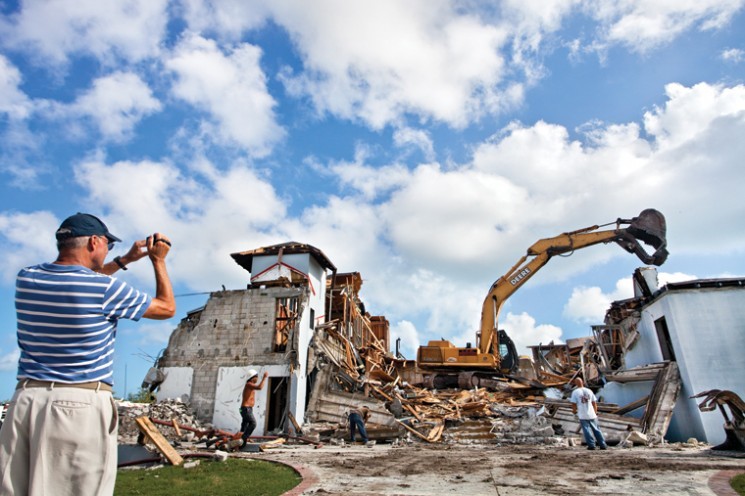
INDIAN RIVER COUNTY — The huge bucket rose toward the tarpaper roof, a good 30 feet off the ground. The backhoe’s arm punched at the house, like a fighter throwing a quick jab. The bucket opened, revealing metal teeth which grabbed onto the roof and shook it.
The roof groaned, creaked and started to give. A handful of Marsh Island neighbors watched as the backhoe operator shifted the machine’s treads up the home’s steps and gave the roof another good tug.
Plywood, metal framing, tarpaper and 2 by 4 studs tumbled into the center of the house as a small cloud of dust rose from the debris.
The home is one of about 14 derelict and condemned properties the county will tear down this year, fallout from the bad economy and distant banks – unwilling or unable – to keep the properties maintained.
The Marsh Island home is at the upper end of the economic spectrum.
Work stopped on it years ago and the owner ignored county pleas to secure the property or finish building it.
“I’ve been waiting for a long time for this to happen,” said John von Hagen, president of the Marsh Island Homeowner’s Association. “I never cease to be amazed at how powerful that equipment is.”
As the backhoe continued to knock down the unfinished five-bedroom, four-bath home – its 7,033-square-feet of unfinished decay visible from the Wabasso Bridge – a few island residents captured the action on point-and-shoot and small video cameras.
Marsh Island residents conducted a nearly four-year long battle to have the house torn down. Action happened when earlier this year the community’s homeowner’s association offered to pony up half the cost – up to $15,000 – to tear down the structure.
County officials agreed to split the cost which will come out to roughly $9,600 each.
Between October 2010 and Sept. 30 of this year, 14 properties were condemned in Indian River County.
Just this month, county and Vero Beach workers are going through the process of condemning eight in the county and one in the city.
The average cost to the county to tear down a structure is $4,175, said Charlotte Bowling, a county senior building support specialist.
Few demolitions happen east of the Indian River Lagoon, said Bowling.
Bowling said that based on history, the county projects to condemn about 18 properties in the next year.
The hurricanes of 2004 and then the toppling of the housing and stock market were a one-two punch for the county leading to a spike in demolitions, said Roland DeBlois, the chief code enforcement officer.
Still, tearing down what was to be a multi-million dream home stands out as one of costliest and rarest around here although it pales in comparison to a project last summer.
The summer demolition of the Gifford Gardens, a subsidized housing complex, ran into the six-figures, said DeBlois.
As for the Marsh Island property, construction on Lot 15, one of 32 in this private community, began in 2007.
The foundation was poured and the walls went up as well as some of the roof sheathing.
And then construction stopped.
In addition to the lack of a completed roof, no doors nor windows were installed, leaving interior walls, floor trusses, roof sheathing and roof tresses to rot over the years.
Both the pool and golf cart garage were only partially built before the owners, Paul Shoquist and his wife Yu- Hang, seemingly gave up.
There is a $3.5 million mortgage on the house with snail-pace foreclosure proceedings underway.
The county will place a lien on the property, though it’s not likely it will recoup any demolition costs as there is a long line of other creditors ahead of county taxpayers.
“It took a long time, but I just kept pushing it,” said Marsh Island resident Jill Jones, whose home is a vacant lot away from the incomplete house.
Jones said heavy winds would frequently pull material off the home.
That was enough to get the county’s attention when the residents implored it to take action because of the potential danger.
County records show Shoquists got plenty of time to get the house back in order.
Thirteen months ago, a letter was sent to the couple telling them to either repair the home or face the demolition process.
The county never received a response, likely in part because foreclosure proceedings had been initiated by Capital One a month earlier in October 2010.
“The bank refused to do anything about it,” said von Hagen, who lives across he circle from the house. “They don’t care about pipes rusting and the roofing coming off. A strong wind could have really caused damage to some of the other homes; there was so much hanging debris.”
Von Hagen also said the bank’s representatives, who are based in Texas, also were unresponsive to homeowners.
As the backhoe’s giant claw continued to rip chunks out of the cinderblock front of the house, metal was plucked from the debris and piled by the side of the road.
“We were really hoping someone would come in and finish it,” said Susan von Hagen, who was scheduled Wednesday afternoon to host about 50 women at her own home for a Vero Beach Museum fundraiser.
Despite pushing for years to have the property condemned and torn down, Jones wasn’t celebrating last week.
“As a homeowner, I watched it go up; the labor, the materials, the resources that went into it,” she said. “To see it all go down is sad.”
Jones then shook her head. “It never should have happened.”



